#nothing feels like a retcon and reading old books i often wonder “....was this planned this far back!?”
Text

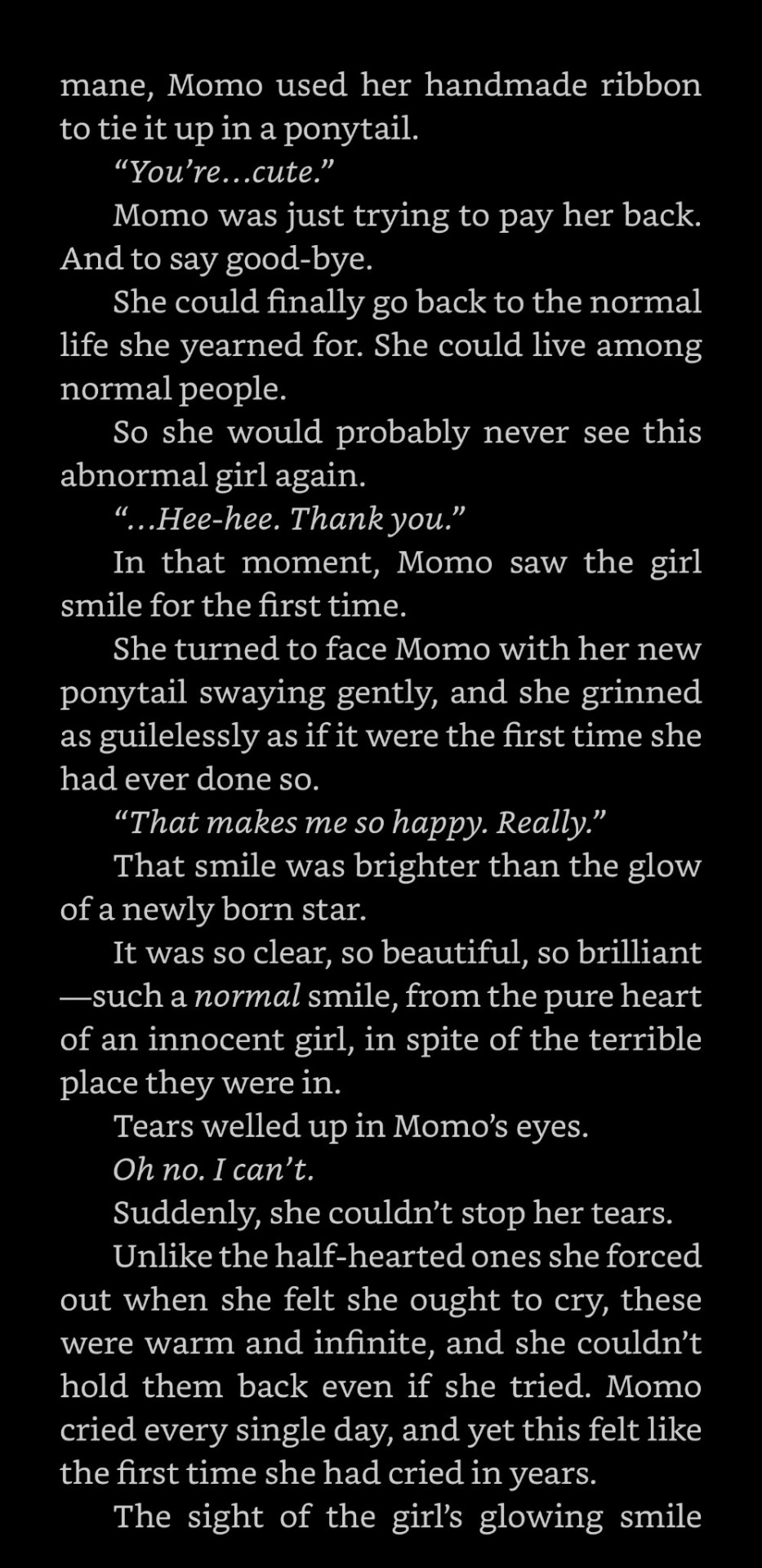
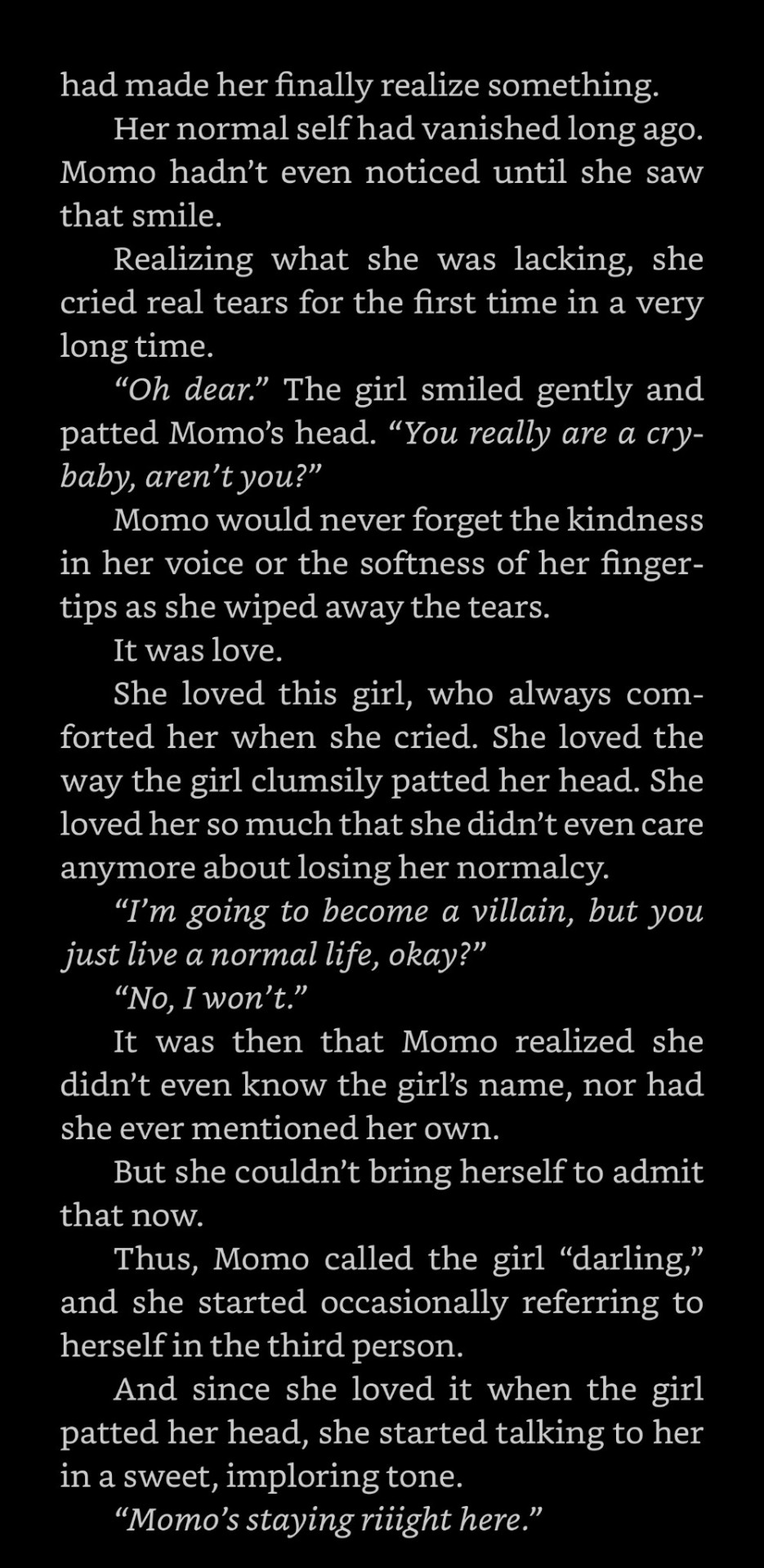
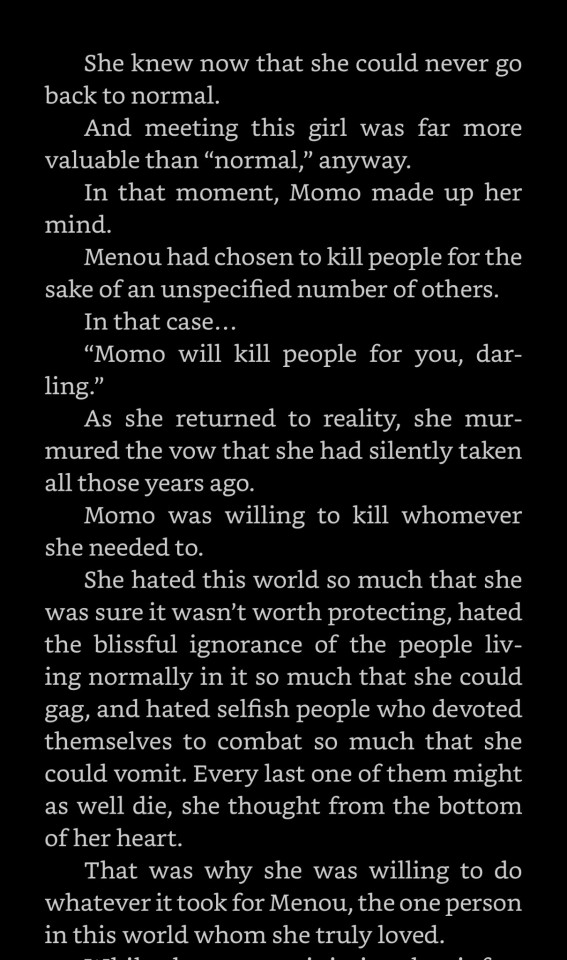

#absolutely insane development lol#one smile permanently BRAIN DAMAGES local girl#momo is a great character#arguably the most human and well rounded#saved by one person's kindness#menou and momo have a great relationship#and momo is genuinely the highlight of anything she's a part in#love love love this character#so honest and flawed and genuine#and very funny#need to take a moment to say how much i love these books#it's so clear the author loves spies and magic and mecha fiction#and it's all combined here so neatly#such an unabashedly geeky series that clearly has a love of female characters#the way the story and lore unfolds and never contradicts itself is so impressive#nothing feels like a retcon and reading old books i often wonder “....was this planned this far back!?”#ty executioner for reminding me why i love reading#shokei shoujo no virgin road#the executioner#the executioner and her way of life
6 notes
·
View notes
Note
Yo Danie, I wonder if you've got any ideas on this; in TAS, transients either get summoned to Tokyo because the app reaches out and makes pacts on people's behalfs with willing familiars, or they get summoned by having, like, a wish of some kind and they end up stumbling through a portal to Tokyo to see that wish fulfilled, right? And then they either get unsummoned, or stick around for whatever reason?
Here's the thing; when they get unsummoned, do they go home? The Red Oni in chapter 1 seems pretty convinced that he's going to die unless you make a Summoning pact with him, but Salomon says later that Shiro's familiar whose connection you cut will just end up going home. Further to that, Macan says about Oniwaka when he's vanishing into light that he's going back to his home world, and then when his strength recovers he'll pop right back in.
The thing is though, that there's a remark early on that Stray Transients, who are Transients without a Summoning bond by the game's definition if I'm remembering right, can only maintain themselves for a while by sustaining themselves on the land's energy. Even further, the actual Housamo wiki says that they'll be unsummoned from the game if they don't find a way to sustain themselves, usually by getting into a pact. Guilds I believe are also noted to be one way around this. Does that mean that if you just wait outside of a Pact, you'll go home? Or would you pop back in again after a bit, essentially trapped in Tokyo?
ALSO ALSO, Bathym says that, though this only applies to "his hella demonic self", demons need tons of emotional energy directed at them to survive, and a pact is the most efficient way to get energy.
But we don't see Sitri in a Guild or a Pact (unless you Pact him, but I'm pretty sure that's non-canon), and Sitri also has a family. They're all demons one would presume, so why does he not seem to need anything like Bathym does? We can derive from this that Bathym was either speaking about himself, and only himself, lying to try and get the Protagonist to make a pact with him, or that Sitri has a Pact he isn't chatting to anybody about, right?
HOWEVER. In chapter 4, we see that the Aoyama guild provides supplies for the enormous number of Stray Transients who have nothing and no prospects, but that those strays are unlikely to be guild members. Further to that, she mentions that the ninjas and many other strays are like, literally treated as the dregs of society. So, how come they're still around? Surely the Stray Transient population should be either dwindling all the time, or in constant flux? But I'm pretty sure there's a notable overpopulation issue in canon because of the sheer number of Transients! Not to mention, if they're treated like dirt and killed and traded, you'd think they'd just...WANT to leave, right? So they could just wait until their connection ran out.
AND ALSO, it's noted in the backstory that Transients started pouring through the gates one day in history, and that this generation has never lived in a Tokyo without walls, but the previous generation therefore presumably did; that means like, it's been at least 2 decades, possibly 3. How long could those Transients have stuck around without a pact going by the lore?
Lastly, the Protagonist has the power to rend Transients connections to Tokyo, canonically. How then, do those Transients come back if they've had their connection severed? And shouldn't the Protagonist offer to go to the slums and ask if anybody would like to go back to their homeworld if that were the case? Or will everyone literally just rebound to Tokyo completely?
Further to that, when people fulfil their wish, do they go home? When they've played their Role out completely, is that the end of their tenure in Tokyo?
Basically, I think the whole system is a little underexplained and I've seen you post thoughts here on stuff, so I was wondering as to what you'd make of it all! Am I missing something?
. . .holy shit anon this is an essay innit lol not that i'm complaining, I just was not expecting it when I saw the notification after I woke up. For the record I saw this at. . .7am or so. It is now 11:55 when I'm finishing it. HYPERFOCUS GO BRRRRRRRRR. OKAY LET'S SEE IF I'VE GOT SOME THOUGHTS FOR YOU.
DISCLAIMER: I'VE BEEN PLAYING THIS GAME FOR LITTLE OVER A MONTH AND I FEEL LIKE I HAVE FAR FROM ALL OF THE DETAILS. I haven't read three of the translated past events yet and I haven't read most of the untranslated content(including Chapter 11 although I'm super tempted you don't even know.) These are just my understandings of things, I suppose.
ALSO IDK HOW FAR YOU ARE IN THE STORY. . .I mean you mention them being sold so you're probably up to Chapter 10 at least since that's where we learn about Daikoku selling transients because it gets him off I guess, although they also could have mentioned it some other time and I just forgot lol BUT. YEAH PROBABLY GONNA MENTION SPOILERS.
TL;DR:
Red Oni: summoned to Tokyo without a pact. When rended from the land would disappear, possibly die. Likely this is because of whatever conditions are happening where they came from or having had already been dead when summoned. Possibly also just a false belief because they didn't know well what was going on to begin with. Possibly also just part of the game plan originally but retconned by the devs then never rewritten.
D-Evils: Shiro's Rule is Ressurection which causes an exception when clashing with Rending. The world of the Old Ones is gone, the D-Evils are familiars created by/living in Shiro's book. Entities, abilities, and artifacts from Old Ones are able to be used outside of the app/battle zones, so D-Evils can exist if Shiro just summons them. D-Evils don't go away when rended because they're part of Old Ones and Old Ones is gone--if they go away they return to Shiro's artifact where they came from. They also donct go away because rending them causes an Exception.
Oniwaka; Zabaniyya; Ophion: rended from EXCEPTIONS not from the world. Were likely sent back in order to resolve the exception after being rended and to recover the energy that sustained their physical forms in the first place, not because they had no means of being sustained in Tokyo. Returned due to pacts with MC, positions in Guild, unfulfilled pact, etc once their energy to maintain physical form returned.
Stray Transients: likely have outstanding pacts and thus do not disappear over time. However, some don't and those proper strays will likely return home after an amount of time, but we don't know how long. Alp has been in Tokyo for a few months but isn't disappearing despite arriving because he wanted to be loved/popular. So unattached transients stay around longer than a few months. They may also be attached to the school they were initially meant to go to to be monitored, or someone who works there. They may not want to go home due to poor conditions, being dead, lacking a home or people to return to, etc. Remember, even in real life people immigrate to places that treat them poorly--but that's because even that and the potential in those places is likely better to them than whatever they're running away from. If the transient arrived in distress it's because they wanted to be away from wherever they started out or because they desperately needed something. This new opportunity may be what they need--to find someone they lost, to find an answer, to simply start life over fresh. Even if they're being abused, looked down on, they may simply be happy to be alive. If they want to go home, they hopefully just have to wait--but you have to live if you wanna get home, don't you? Best to survive as well as you can.
Stray Transient Population: constantly increasing to sustain/grow the Game for the World Representatives. The overpopulation is deliberate. They do not care about the wellbeing of these people, they only want to create a stadium to fight in, and for that they need more transients and app users than humans not using the app in Tokyo.
Sitri: Aside from forming a pact with him, Sitri's Sacred Artifact is his wings/are his feathers, which cause people to fall in love with someone who touched them after the feathers that had been touched are attached to a second party. Sitri feeds off of the love directed to him. This is troublesome for him more often than not, but I'm pretty sure that's how he gets the emotions he needs to eat if not via pact.
Being around from the start?: The gates appeared in 1999--it's been at least 20 years, assuming the game takes place anywhere near the present year. Off the top of my head we don't know if any stray transients have stuck around for extended periods. How long someone's been in Tokyo rarely comes up. We know Yule has been in Tokyo for a few years because he went to middle(elementary? Idr) school with Ryota. Sitri is similar with Kengo. As such, given Sitri and Yule aren't in guilds as far as we're aware, assuming being attached to a school doesn't make one connected to Tokyo, we can assume they're stray transients. This means that they'd been here for years, as strays. Given we know stray transients disappear eventually, it's safe to assume that there have been stray transients who disappeared and went home. Assuming it isn't different per individual, stray transients can stay in Tokyo for several months to several years, but to my awareness there's no set number.
Going Home: in order to go home a transient who's been summoned must fulfil their summoner/pacted humancs desire. Surtr, Azathoth, and Babalon all disappear after fulfilling Arc's desire for them to be their family, leaving behind their sacred artifacts which contain their memories until they disappeared. So, yes, fulfilling the desire entrusted to a transient/playing out their role will cause them to fulfil the conditions of their pact, causing them to disappear. However, we don't know what happens when they do. Thus far, those three haven't come back despite the reset occurring. Arc was able to summon their artifacts but otherwise could not reach them. Their artifacts were taken by Breke who was able to channel the memories within and allow Arc to communicate with Azathoth's memories.
SLIGHTLY MORE FULL VERSION WITH A COUPLE SCREENSHOTS
(read the tl;dr anyway because I probably remembered things while Inwas writing it that I didn't remember to put in the 'full' version lol I WROTE MOST OF THE LONG ONE, WROTE OUT THE TL;DR, THEN FINISHED THE LONG ONE SO. PROBABLY WANNA READ BOTH.)
Transients arrive in Tokyo either by being summoned, by being summoned ACCIDENTALLY(someone wishes to have friends/meet someone new, etc), by being pulled in by the Rainbow Of Transient Light randomly(?) sucking them up when they're in distress/have a wish to fulfil, or some combination of those.
In Macan's character quest, MC and Macan learn that the one who technically summoned Macan was MC. The same thing happens in I think Xolotl's. They end up going to the collided past--or a collided memory?--and when past!Macan is in distress over being alone, MC approaches him and says they're there for him, however past!Macan can only hear them, not see them. He calms down and asks if they're searching for him and says he's going to find them--which causes him to disappear and be summoned to Tokyo in search of this person who wanted to be by his side. Macan realizes that's exactly what happened to him--he heard a voice saying that they were with him and, in his desire to no longer be alone, the transient light came along and took him.
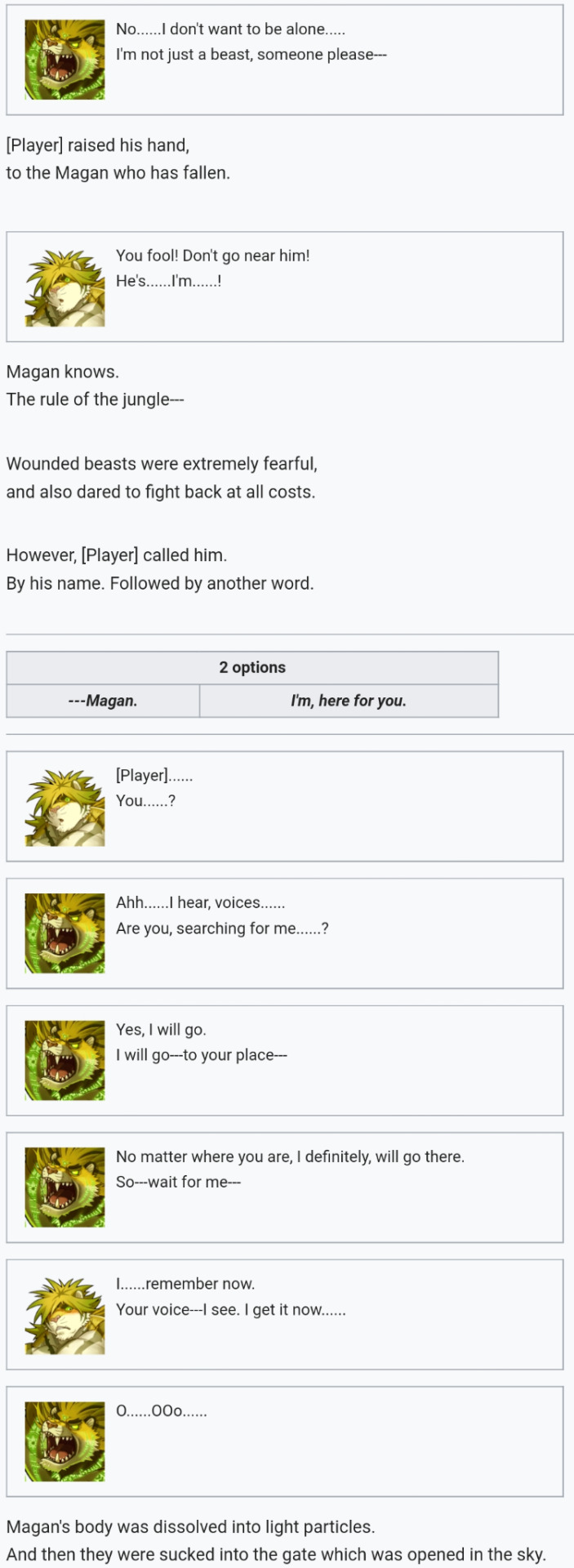
(it's written as 'Magan' in Japanese hence why it's written that way here--this was likely translated before his English name was given.) (Such a request, perhaps, means that he's with MC until he's dismissed by them specifically.)
Xolotl was running from being sacrificed to Tezcatlipoca and MC and future!Xolotl protected him. Seeing himself be weak and seeing himself be strong enough to try and protect MC and seeing MC who refused to leave him and hearing what they had to say, he desired the strength to live with the people he loves and for there to not be sacrifices again. He may not have gone to Tokyo if he hadn't realized that desire through meeting himself and MC. In fact, he may not have survived at all(though maybe Quetzalcoatl would've protected him if not collided MC and present!Xolotl.)
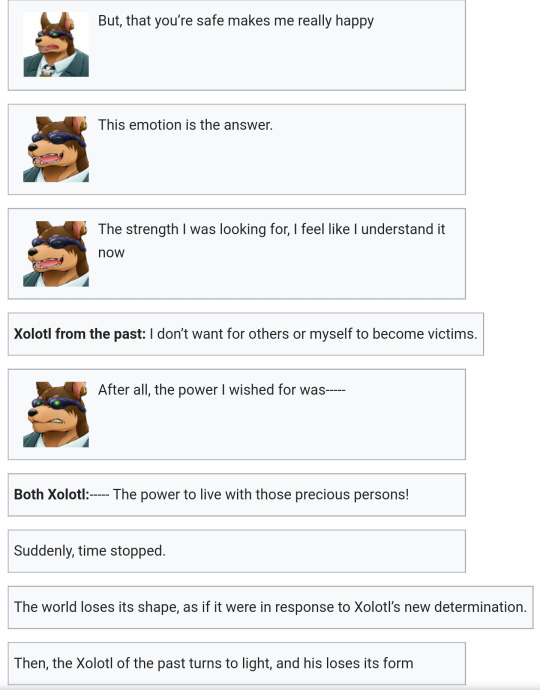
SO. If you recall correctly, MC is implied to be a transient as well. There's also the possibility that they're not, and simply are some poor sob the Game shoved 23+ memories in at once, broke the memories of the host in the proccess, and thus we have MC coming to in a park confused about everything but their own name(of course if that were the case surely someone in Tokyo would recognize them beyond their being the trophy/exile from their home world, so it's not likely.) Lil Salomon says that as a summoned transient they can only go home if they find and fulfil the wishes of their summoner. However they neither know who or where their summoner is.
Transients can appear simply due to someone's desire for companionship. But they don't necessarily appear atop that person, hence not knowing their summoner. They just hear a voice, may not even hear exactly what's being said or asked for, and the light picks them up and drops them off with no further info or ceremony. So if someone is pulled into Tokyo this way they have a summoner even if they don't know it--even if the summoner themself doesn't know. So they won't just disappear over time unless that person unwills what willed them there or they die or something. Plus we don't know how long stray transients stick around if they have no pact/summoner--we just know that they disappear eventually. It's more than a few months, because Alp showed up a few months ago and hasn't disappeared yet.
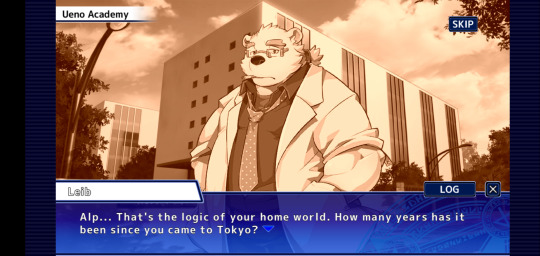

Several characters are attached to guilds which may keep them from being Strays. However some, to our awareness, have neither summoner/master nor guild. At most they may be attached to schools. Sitri, as you mentioned, is one of them, as is Yule--whom Shiro refers to as a stray transient he sees every year without being corrected(although the situation wasn't exactly a good time to clarify that lol.)

Both of them have been in Tokyo for years without disappearing--and the app is a kind of but not super recent creation, so guilds likely didn't sustain them this whole time. Neither have disappeared. Of course someone may have summoned them or they may be part of guilds without it being stated or perhaps being in a school has the same effect as being in a guild. But we don't know that for sure, either.


(Japanese middle school is from 12-15 years old. Kengo's a second year High School student now, so 16-17 years old. Sitri was a first year while Kengo was a third year, so there's two grades between them. Sitri's been in Tokyo at least 2 years. I believe he mentions seeing Lucifuge in a magazine in Ghenna so he hasn't been here his whole life either. So a few years, but not 15.)
Transients that disappear don't have pacts but transients that come back probably do/have formed pacts/attachments to the world. Remember, Oniwaka, Zabaniyya, and Ophion say to call on them if you need them. They're attached to the player now, perhaps having formed a pact incidentally, assuming the situation that brought them there in the first place isn't still in effect(or they're not still bound by, say, their guild.)
Also, much like in real life, sometimes whatever is home is worse than the horrific things you deal with wherever you immigrate to. Or perhaps you've formed attachments somewhere you've arrived and are willing to endure suffering for them. It's rarely as simple as "we're suffering, we wanna go back to where we came from." Especially since transients likely arrived due to distress or wanting to be anywhere else but home. Some of their worlds don't exist anymore(Old Ones) or are collapsing(Yggdrasil; El Dorado.) Some people have no one and nothing back home and this is a new start for them, even if the start is bad. Also they could be waiting until they go home automatically, but what're you gonna do while you wait? Probably live your life as best you can. If you're gojna be stuck somewherefor a few months you may as well make yourself at home.
So why doesn't MC go around rending people themself?
Well, for starters, they're made to be a high school student most of the day. Where would they find the time lol. Second they're a bit busy trying to save the world and all. . .and if some teenager wandered up to you and said they could get you home if you had an app battle with them, would you really believe that when you've been told your best bet is to either find your summoner or wait out your incidental connection to the world? Sounds like a kid trying to stir up trouble, and not all transients have the app anyway. I mean really would you expect the local homeless population to have smartphones? Probably not.
Furthermore. Spoiler alert
This system of the game, the gates, the transients, it's no accident. It's intentional. Tokyo is the setting for this inter-world competition to prove which world is strongest or something to that effect--and the winner gets MC, the host of the exiles and perhaps some kind of powerful system. Of course what they do with MC is up to them. The Warmongers want to keep the game going so they can fight the powerful MV over and over again forever. We don't know what the Invaders want yet afaik but based on the name I'd assume they want to use MC as a super soldier to conquer other worlds. And the Rule Makers want to use MC to support one of their own worlds as its System. /smacks MC on the back) this baby can hold SO MANY rules and roles! Hold up a whole damn world apparently!!
So think of it this way. . .they could go around rending everyone until the transient light returns them home or to the deaths they desire. . .but would the World Representatives really allow that? They'd just keep bringing in transients. They need to fill Tokyo with them--until transients and app users outnumber the humans naturally belonging to Tokyo--so they can have their little contest.
MC alone would never be able to pull off sending everyone home as long as the Game is running. The worlds would not allow their contest to be ruined.
As for who goes where and does what when unsummoned. The Red Oni hadn't been there long. And perhaps wasn't summoned in the first place, nor had anyone likely explained much to them for that arrival. Also if you felt yourself disappearing, felt your connection to this world just torn off and uprooted and fading away, even if you knew better you'd probably think you're dying. That'd be scary. You'd want to avoid it.
Of course it's also possible the oni was dead or dying to begin with and their connection being severed would send them back to death--like Shino, who'd died long ago in the Land of Wa and when he died in Tokyo he went back to being dead.
The D-Evils don't have anywhere to go back to besides Shiro's book. The world of the Old Ones is gone. As such "home" for them is back with Shiro--and remember, their rules clash anyway. Rending and Ressurection don't mix. MC couldn't rend the D-Evils from Shiro properly because it causes an Exception. At best rending them will send them back to the book until Shiro summons them again. Plus, entities from Old Ones can use their powers without the use of the app--including those with Old Ones artifacts. Shiro can summon the D-Evils at any time, even outside of an app battle--so to send them 'home' doesn't really send them anywhere but back to Shiro since they both have no home to return to and were summoned to exist in Tokyo.
Demons needing to recieve emotions seems to be more of a feeding thing than a transient connection one afair. Like Alp eating dreams--he'll die if he doesn't. It's like "I need to external feelings or I'll starve" not "I need external feelings or I go back to Ghenna." Sitri likely survived thanks to his feathers--his sacred artifact which cause people they attach to to fall in love with whoever touched them previously--causing a constant stream of love towards him as he needs it. As such he doesn't need to have a pact to live, he only needs to make people fall for him to absorb that feeling and then take his feathers back to stop eating.
The canon-ness of MC making pacts with everyone is perhaps debateable. However events, character quests, special quests, etc have characters refer to Mc as Master or Summoner. And the story can sometimes reference events and such(see: meeting characters in events before they're part of the main story, meeting them in the main story, and being able to go "didn't I meet you in [season/holiday]?" And they go "yeah, we did! It's nice to see you again!" So technically events and the like are as canon as you make them. Also having a pact doesn't mean that person can't be your enemy or can't hurt you or is fully at your command, which means that it doesn't necessarily not make sense that characters can be in pacts with/summoned by the player while still being against them. MC likely has the ability to form pacts easily/unconsciously.
This is likely(and this part is speculation!) because of MC's role as the Wanderer--as the host of the Exiles of the many worlds, they're a system in and of themself(or they'e able to be one.) As such attachments to them are like individuals having 'faith' in them, the way Systems sustain worlds. Especially those who had some relationship with or attachment to an Exile they host. This may also cause a pseudo pact with people they meet and get attached to(and are attached to them in turn, not necessarily in a positive way)--like people believing in a faith. The attachment to them, love for them, hate of them, fear of them, is a sort of belief that causes them to be able to stay in Tokyo longer because they are now unwittingly part of MC's system. After all MC is a transient and transients, as far as I recall/understand, don't summon other transients to Tokyo, they only summon artifacts because bringing a whole person and their memories requires a strong means to bind them. Transients' connections are already dependent on someone/something else--which is already taxing as a pregnancy--and that'd be hard for them unless they were born into Tokyo.
In cases like Oniwaka and Zabaniyya and Ophion, they likely needed to disappear temporarily in order to resolve the Exception on top of regaining energy to sustain physical forms in another world. Think of it like closing a program on your computer. If the program clashed with another and an exception occurs you close the one of lesser importance. You can then maybe open it again once things have cooled down with your proccesser and it can handle them at the same time--thus, they come back to Tokyo even after being dismissed by fixing the exception.
So they pop back in because they're still bound to Tokyo. MC only rended them from the exception, not from the world itself. But transients who truly have no connection will go back and stay until summoned again. . . .
(Now that I think about it when someone fulfils the reason they were summoned to Tokyo they disappear and seem to disappear for good. We don't know if they die or what. They've been eliminated from the game. This happens with Surtr, Babalon, and Azathoth. After they successfully, properly became like Arc's family and that desire was considered fulfilled the pact was complete and they disappeared, leaving behind their artifacts.
Red Oni may have been summoned to be a tutorial for the player. But also a tutorial for the player character. Red Oni thus would go away completely after fulfilling that desire of whoever summoned them, thus giving them their fear they'd die because they'd served their purpose.
I just happened to remember/consider that lol ANYWAY.)
Basically it's a bit underexplained I agree.
But that's because you, as the player, as the MC, aren't supposed to know everything that's going on. You're supposed to learn as you go while also being denied information by the Powers That Be. You don't have your memories, you don't know what's going on here until you see/experience/hear about it. It's part of the immersive understanding/storytelling proccess. The characters don't tell you how things work because they only barely understand it themselves--and then when they learn 'this isn't just a game, this isn't just coincidence, there's something greater happening here' everything they know gets thrown into question. The people who do understand it aren't going to tell you much because they don't want you to ruin their game. You're just the final boss and the trophy to be won--and possibly the system upon which the game resides, resetting every time you die so you can struggle to be won someday.
You "can't win."
So you don't need to know how it works.
That doesn't stop you or anyone else from trying to find out, though, nor does it stop you from trying to change it.
. . .I hope that helped a bit! 8'D I don't think you missed much, really. You're right in that it's underexplained but That's Storytelling, Baby!
#danie yells answers#danie yells at tokyo afterschool summoners#danie yells with anons#long post#tokyo afterschool summoners#as someone who learned that they like telling reader-focused stories#the storytelling method of 'show don't tell' tyat's being used here#where you don't know anything abd you only learn as it happens to you#i enjoy it a lot is what i wanna say lol it's like#we can all speculate together because it's less 'you haven't read all the meta!' and more 'we don't know yet#ofc i'm not the expert and icm not as informed as people whocve been here longer so#if i'm wrong anywhere or leaving things out or other people have input i'm super open to hearing it and i'm sure anon is too!
7 notes
·
View notes
Text
My bottom five new-to-me movies of 2020
2020 sucked. So did these movies. Before I do my customary top 20 favorite movie discoveries list, I wanted to share five very special new-to-me movies that were painful to watch. Forgive me if it all sounds like ranting. It probably is.
(And remember-- if you like any of these movies, that’s fine. I am not attacking YOU. I just didn’t like a movie. I know this is a stupid disclaimer to put on a list of opinions, but combing the venomous old IMDB message boards has me on edge a bit lol.)
Star Wars Episode IX: The Rise of Skywalker

Whether you love the sequel trilogy or hate it, everyone pretty much agrees this movie was a mess. I thought no movie could have a more structurally unsound screenplay than The Crimes of Grindelwald, but Rise of Skywalker gives it staunch competition. It creates a new artform from making things up as the plot requires: new powers for Rey, new Macguffins to pursue, new motivations and backstories for characters.
I admit I dislike The Last Jedi. I dislike it a lot, actually, and it appears JJ Abrams did too from the amount of retconning he does here (Rey isn’t nobody! Honest, guys!). But you can’t backtrack THAT much. Either plot out your entire trilogy before shooting the first film or play fairly with the cards you were dealt by the filmmakers of movie two.
If anything, these movies have become a cautionary tale about not having a plan when making a movie trilogy. Now, George Lucas didn’t really have one either when he was making the original trilogy, but in that case, he wasn’t even sure the first movie was going to be a modest hit, let alone the biggest movie of the 1970s. He had an excuse and did well enough finishing the trilogy. Here, Disney knew there would be sequels, they knew they had a hungry audience, but they chose to just wing it and the results are just-- so disappointing, especially given the talented young actors and lovely special effects they had at their disposal.
The more I think about it, the more poetic the image of Palpatine hooked up to a life support system/crane is. The best ROTS can do is riff on earlier, better movies and hope our affection will make us overlook the awfulness.
Artemis Fowl

Outside of Animal Crossing, Artemis Fowl might have been the only entity to benefit (if only slightly) from the pandemic. I cannot imagine it would have been anything but a box office bomb had the theaters been open.
Artemis Fowl feels like it should have come out in 2003-- not just because the books were more prominent then, but the whole style of this film in general. In 2020, it’s positively anachronistic. The whole thing is a joyless attempt at dipping from the old Harry Potter well, with a bit of Spy Kids thrown in for good measure. Beyond that, it’s so poorly done as a whole. I have never read the Artemis Fowl books, but I watched this with a friend who has and his head near caught on fire. Apparently, it cuts out everything that made the books cool, like the protagonist basically being a kid version of a Bond villain. Here, he’s anything but that: he’s the usual bland child protagonist surrounded by a cast of slightly more interesting characters. Josh Gad seems to be the only one really trying. Judi Dench shows up and somehow gives a worse performance than whatever the hell she was doing in Cats.
I was actually shocked Kenneth Branagh of all people directed this. I generally like his films, even the less successful ones like his musical adaptation of Love��s Labors Lost. Even the uninspiring live-action Cinderella remake he helmed is at least pretty to look at-- Artemis Fowl has neither brains nor beauty to recommend it.
Bloodline

This film was intended to jumpstart a career comeback for Audrey Hepburn. This decidedly did not happen. One has to wonder what she saw in this sordid material in the first place. Maybe she really just wanted to work with director Terence Young again? Or she thought this would be a good, more modern take on her screen persona? I have no clue. All I know is that Bloodline is one of the worst big-budget Hollywood movies I have ever seen.
No contest: this is Audrey Hepburn’s worst movie. Hate on Green Mansions and Paris When It Sizzles until the stars turn to ash-- at least there was some fun camp value in them. The plot in Bloodline makes no sense, going into unrelated digressions that lead nowhere (did we really need that extended flashback about the dead father? or the subplot with Omar Shariff’s two families?). Oh and then there’s the awful sleazy snuff film subplot that’s also poorly developed and goes nowhere. Hepburn is game, but she can’t save the sinking ship. The best she can do is be charming in a terrible 70s perm.
Luckily, she made the underrated They All Laughed two years after this cinematic fecal matter bombed, so at the very least, Hepburn’s big screen swan song was a film worthy of her presence. (Hint: there will be more about that movie on my top 20 of the year list!)
Halloween III: The Season of the Witch

You all have no idea how excited I was to see this. All the mentions of it on Red Letter Media made it sound like deliriously entertaining schlock. I mean, it’s a movie in which the villain sells cursed Halloween masks that turn children’s heads into bugs and snakes! That sounds awesome! Instead, the movie is badly paced and boring: the main characters are uninteresting and the plot takes an interesting premise then does.... nothing with it. Nothing whatsoever. The second act is the cinematic equivalent of treading water. In fact, so little happens, that the filmmakers squeeze in a pointless sex scene between two character who have all the chemistry of a lit match and a bag of M&M’s.
The thing that annoys me most about this film is that it killed off a great concept: that all of the future Halloween films would be standalone stories centered around the spookiest time of the year. Unfortunately, this movie botched itself so badly that people often think the absence of Michael Meyers was the problem. It wasn’t: it was the absence of a good story.
Blindsided
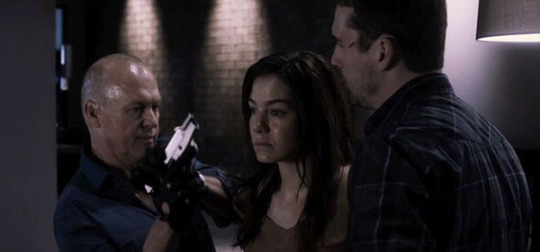
This is probably the most watchable movie on this list, but that’s not saying much. A bloodless ripoff of Wait Until Dark, Blindsided is an unimaginative thriller with no thrills, humor, or interesting characters whatsoever.
The whole film is just repetitive. The situation doesn’t slowly boil to something horrific, the threat presented by the villains doesn’t escalate, there are no interesting interactions between the characters: no, here the underdeveloped protagonist is interrogated, tortured and/or sexually harassed, tries to escape, is recaptured, rinse and repeat for ninety minutes. I admit there’s some clever resourcefulness on the part of the heroine in the last scene-- but it’s basically just Wait Until Dark’s climax (down to the twist with the villain finding an alternative source of illumination for crying out loud!) without the emotional payoff that comes from slow-burn pacing or the fantastic performances, so even that’s a letdown.
I thought the movie might at least be saved by Michael Keaton as the main criminal mastermind since he’s shown he can be a great villain in other movies (if they had remade Wait in the 80s, he would have been a perfect Harry Roat Jr.), but even he seems to be phoning it in here. Beyond a scene of attempted cat murder (I’m serious-- the bad guys are so incompetent they can’t even kill a cat), there’s not even anything so bad it’s good to enjoy. Blindsided is just dull and by-the-numbers.
8 notes
·
View notes
Text
Into the Object Hole:
Why is Nearly Every Object Show Flash-Animated?
(warning: a big, gigantic ramble generated by the mind of a comic artist)
I’m asking this question because I was bitten by the “Object Show” bug myself! It’s become a niche but easily replicated genre of its own within the animation community. Starting with the eponymous Battle For Dream Island (a show I think we’re all familiar with), we’ve seen many creators follow suit in the seemingly simple formula of having a bunch of inanimate objects participate in a game show-esque competition.
This is not to claim that Object Shows are unoriginal or overdone at this point: on the contrary. With the advent of resources for learning writing, animation, et cetera, I feel there’s a massive amount of potential that this community has, until now, mostly neglected. Battle for BFDI is, from what I can tell, reveling in its own, unique premise in the way it wants to. Inanimate Insanity’s second season has, as of late, recognized its potential to communicate a story about change and growth within individuals and the world around it. Unfortunately, I haven’t watched many shows, but I feel I’ve gotten my point across.
In another post, I asked about shows that didn’t use Flash, so i’m going to be responding to those before I embark on my tangent.
@apcwoc said: djshjksjhhdj most of the shows are probably done on flash because a lot of them were started when the og creators where much younger and flash is the easiest and most reliable to use when people start out animating
that’s a common thread i’ve been finding!! one of the earliest object shows, Animation Island by legotd61, was created a year after BFDI—and at the time, legotd61 was 7 years old. granted the animation & visuals aren’t the most jaw-dropping thing in the world, but they were a kid so it’s automatically charming. in like, a kid sense.
@demi-gray suggested Modern Objects as a non-asset-using show!
youtube
Unfortunately, it still relies on assets for arguably the most important visuals: the characters! They do use the capabilities of Flash more extensively than other shows (that I know of), which makes watching the characters do their thing a lot more fun and engaging. The unique style compared to other shows definitely helps out a lot as well!
@payjayisgod said: i mean, i do frame-by-frame all the time, but for the sake of saving time i’ll be using assets for the bodies (gonna try doing everything else with frame-by-frame) in my own series i’ll be making with some friends ^^“ if you wanna see my animations my youtube is Icedog McMuffin :0c
PLEASE show me your show when you do it, because your animations are!!! really cute!!! also i’d LOVE to see stuff that takes the path of Modern Objects: with asset bodies, yes, but everything else is done according to the needs of the visuals. Use your medium to the best of its ability!
@dottival said: I once saw someone who Wanted to do frame-by-frame, but they never got their show off the ground. Mostly because they never really started??
you can’t just. tell me this. and not say who this person is (unless they want their identity under wraps, which i’ll respect)!!!! I’d love to ask them about their thought process towards their show, unless they didn’t actually plan much. I want to do some... ReSearch....
Speaking of planning, the thing that enchants and haunts me most about object shows is how much is going on behind the scenes. This is for any animated show, really, because as a bitty comic artist, I had no clue where to begin. I’ve started to draft and worldbuild for my own show, but I can’t help but wonder how much of it is done for other object shows.

(this is a thumbnail for a setting on my show!)
The medium, by default, demands attention on the characters at the forefront. The premise generates interest, the aesthetics (aren’t necessary but) lead viewers in, and the subject(s) of the show is what keeps audiences engaged. No matter what the creator(s) choose as the subject, they must make sure it’s polished to their best abilities, while ensuring other elements of their medium is properly balanced.
If you’re creating a character-driven narrative, for example, you’ll want to focus on the development of your characters. And, since it’s easiest to relate to concrete characters, that’s what novice content creators focus on developing as their content’s primary subject (and what professional content creators master).
However, the development of, say, a character is more often than not put into the hands of the viewers. How? Viewer participation: having the audience vote off who leaves a competition.
An interesting concept as, typically, animated shows require oodles of planning in order to convey the story it wants to the best of its ability. This makes the typical object show a challenge (forgive the word-play) to pull off properly, despite being deceptively simple enough of a feat on the surface. Character development can be volatile, as any character can be booted off (depending on how well you can predict a character getting eliminated).
Following this, the difficulty of creating a cohesive and well-written story through the Object Show format is very, very high. After all, you need to place time in your resources as wisely as possible, in order to avoid taking too much time on an end product you may not even like a little while later. The elimination of one character may upset a part or the entirety of the show’s plotline, if a creator is not careful.
Inanimate Insanity’s writing was able to excel at its greatest the moment viewer voting was dropped. One of the best shows in this genre (in my opinion), Modern Objects, isn’t even an object show: it’s formatted like a sitcom, and focuses primarily on characters and comedy. The one object show I was able to find that was primarily frame-by-frame animation (thank you, @bfb-basard!), Race to the Mansion of Tomorrow, is 100% script-driven; meaning, no viewer participation. This is the same for a few other shows as well, though I am not aware of them at this point of time.

(a snapshot of my animation process: this is for an animation of my OCs Milt and Malt, put to the audio of Big Bill Hell’s Cars.)
So why Flash? The answer is because it’s just easier. Not in the sense that the animators of these shows are lazier, but because animating in Flash saves time. Unless you’re putting all your stops into your show, or the contestants will always be present / aren’t quite as important to the narrative, you absolutely cannot afford to waste time and energy on things that can get thrown away later. Either that, or you don’t know where a character or a plotline or what have you will build up to, so you want to make sure whatever you do make isn’t wasted.
(Granted, I always feel there’s always time for weird plots to be resolved until it’s the very end, but retcons are also an option?)

You see this video? It’s a pretty simple animation of just a little softball walking around.
It took me 2 or 3 hours, give or take, to finish. Nearly every frame is unique, and I drew them all with my hands and my tablet, nothing else. All moving parts are either animated in 2′s or 1′s—the latter of which being 1/24th of a second. There are 35 drawn frames overall, stretched out onto 127 individual frames that constitute the entirety of the animation.
In other words, this clip is 5 seconds long.
If you want to finish an object show within your lifetime, let alone within 5 years, then Flash will be your best friend. It’s good, revolutionary technology that will make your life easier. With Flash, you don’t have to draw things over and over and focus instead on the motion, not the artwork.
Not only that, but being able to finish in a timely manner will help smaller content creators as, since we’re small and have small audiences, not everyone has a long enough attention span to hang onto you for decades. Certain shows like BFB and Inanimate Insanity have the advantage of popularity, so they can take their time with both the show and life (but they’re still rushed by their audience anyways so it’s a double-edged sword).
If you want to tell a story, consider what medium you tell it through wisely. Animation isn’t the only way, but I know for a fact that, if I get there, my show will be frame-by-frame. Why? Because I consider the artwork and the motion in my story just as important as my characters, if not moreso. You might not.
You can make it 3-d animated, claymation, traditionally animated, digitally animated, Flash, frame-by-frame, what have you. You can write your show as a novel, a script, a screenplay, a radio play, what have you. You can illustrate it as a children’s book, a comic, a graphic novel, or even an illustrated novel.
One of my favorite shows, up there with Modern Objects, is a comic by @swabsbloo called Escape From Abject Reality (which you can read on it’s own blog at @efarwebcomic! Please read it! PLEASE READ IT! PLEASE!!! PL). Swabsbloo takes the premise of object shows and simultaneously puts it on its head while playing it straight: a bunch of objects wake up in an oddly absent field, only to figure out they’ve been trapped in a game show-themed death trap controlled (...?) by a(n apparent) sociopath named Snake Oil. You should read it. You should read their comic.

Hell, does your object show even need to be an object show? You can create stories that are beyond inanimate objects, or stories beyond competitions. Again, Modern Objects isn’t a competition show. You can base your characters off of objects as well, without needing to make them explicitly an object. The show I mentioned earlier, Race to the Mansion of Tomorrow, takes this latter approach for the most part!
youtube
As a storyteller, what I obsess about the most is storytelling. I love seeing all forms of it, and the potential that this community’s genre has astounds and fascinates me. The way in which we view the story doesn’t have to be important, but I find the ones I enjoy the most are the ones that utilize its medium to the best of its ability. It doesn’t have to be the best, it just needs to try.
So what do you want to try?
#osc#object show#bfb#inanimate insanity#analysis#long post#the coward speaks#modern objects#efar#escape from abject reality#rttmot#race to the mansion of tomorrow#its#it's the show#my art#mango's art#wip#apcwoc#demi-gray#payjayisgod#dottival#bfb-basard#please god save me from these tags#anywho!!! i hope!!!! this made sense!#i basically went on a tangent every time i started a tangent so like#there is a LOT of text#i tried putting some images & videos to make consuming easier#but i couldn't put links because otherwise tumblr would destroy this post#i am UP for TALKING ABOUT THIS!!!#because i think this phenomenon is kind of fascinating
79 notes
·
View notes
Text
Wonder Woman #50 postmortem: “You know how strident Wonder Woman fans can be”
I want to cap off my readthrough of this unmitigated shitshow with a look at a recent interview James Robinson did with Newsarama, reflecting back on his twenty-issue Wonder Woman run.
I’m doing this for two reasons: One, because having read the full run and formed my own impressions (and, dare I say, some rather strident opinions), I genuinely do think it can be interesting to see what the writer has to say about it, what they were trying to achieve with it and, looking back, how they feel about the run.
And two, because having read what Robinson has to say, HOOBOY, I HAVE A FEW THOUGHTS OF MY OWN.
Newsarama: James, the one through-line of your entire run is Wonder Woman's twin brother, Jason. I know he was the motivation for you working on this book. Did you know the whole story before you started? Or did this story evolve as you wrote it?
James Robinson: I knew to a degree. As you said, I was specifically asked to pay off the gigantic plot point that Geoff Johns had left at the end of "Darkseid War." So it was always part of my plan.
Are. You. FUCKING. KIDDING ME.
The entire premise of this run. The wholesale derailment of Wondy’s Rebirth story. The rampant shredding of her newly-established Rebirth backstory. Sidelining Diana for the better part of a year in favour of a repulsive twin brother and some shit with Darkseid.
ALL OF THAT.
Served no wider purpose.
Was not intended to build towards some Rebirth metaplot or contribute to an overarching Justice League story.
Was mandated, in fact, for no other reason than that Geoff motherfucking Johns wanted to TIE UP A DANGLING PLOT THREAD FROM TWO-YEAR-OLD CROSSOVER.

He goes on.
Originally, I was going to be on it for a shorter period of time. I had originally planned to be on it for about eight issues, I think. And then when I was getting the twice-monthly book in on time (which is tough; they really beat you up), they asked me to stay on.
There are better, more eloquent arguments against the fortnightly publishing schedule — which is incredibly punishing for creators and prioritises quantity ahead of quality — but none, perhaps, are more simple or succinct than James Robinson got to write twenty issues of Wonder Woman because he got his scripts in on time.
And that gave me more time to develop Jason and play with him more.
I was careful to make sure it wasn't only about Jason, however. I was already getting crap from social media about how this is Wonder Woman's book and she should be the center of attention at all time. You know how strident Wonder Woman fans can be.
Well, that’s an interesting and thoroughly disingenuous interpretation of the critique.
The criticism was not that Wondy must be “the centre of attention at all times”, and therefore Robinson was wrong to spend any time developing any character other than her.
It was that Robinson turned Diana into such a passive, reactive — and, frankly, incompetent — character that she became barely necessary to the story at all. You could remove her from most of the issues in the Darkseid arc without affecting the progression of the plot at all, because she never does anything.
Yes, I got irate when Diana would routinely show up in six or seven pages of an issue, if she appeared at all. Funny thing, when I pick up a book titled Wonder Woman, I expect to occasionally see some actual WONDER WOMAN.
But that was the symptom rather than the problem. Because even when Diana was on the page, she was absent from the story.
And part of this is also about the characters Robinson chose to focus on instead of Wondy: Jason, Grail and Darkseid. Three characters that a lot of fans weren’t interested in, didn’t like and frankly resented having shoehorned into Wondy’s story. True, Robinson may have been asked to include them in the story, but it was his choice to prioritise them over Diana, and it was his writing that shaped Jason into such an odious character (something he confirms in the interview: Johns came up with the idea, he says, but “Most of who the character is now is stuff that I've actually come up with.”)
Put it this way: I didn’t see anybody complaining in December 2016 when Greg Rucka devoted an entire issue to Barbara Minerva’s backstory, did you?
But oh, I’m sorry, was that too strident for you?

Nrama: During your run, you tied into several events that were going on elsewhere in the DC Universe. Even this current story arc ties into Dark Nights: Metal and involves the Justice League. Was that a goal, to make Jason part of the greater DCU?
Robinson: Yes. I always do that stuff, though. I always try to tie into bigger stories. Whether it was my stuff at DC or what I did at Marvel, like Fantastic Four and Invaders and what-not, I always enjoy that about comic book universes. I like when writers try to embrace the whole place.
Here’s the thing about this.
I like the sandbox nature of a shared universe. I’m not a fan of event tie-ins, which have a tendency to derail the stories of individual books in order to aggressively market some company-wide crossover that I couldn’t care less about, but I like that there’s this whole wider world of heroes and villains and settings and mythologies that writers can draw on and play with. And you can tell some really cool stories out of the collision of those different mythologies and characters — think Phil Jimenez’s ‘Gods of Gotham’, for instance, where the Wonderfam and the Batfam are forced to team up when some of Batman’s most powerful rogues are possessed by Ares’ children.
That’s not the way Robinson loops the wider DCU into his stories, or at least it wasn’t in Wonder Woman.
Robinson goes for insider references, often obscure ones, of the sort that will only make sense to people who’ve been reading the same comics as him over the past three decades.
In WW #33, he introduced and then immediately killed off a rebooted version of the Atomic Knights in a four-page sequence that added nothing to the plot.
In WW #42, he featured a flashback to Jason fighting the Deep Six, a group of Jack Kirby villains. Ostensibly this is framed as a set-up by Grail to orchestrate her first meeting with Jason, but Robinson milks it to crack jokes about Kirby’s 1970s dialogue — and if you’re not familiar with the characters (as I wasn’t), their inclusion makes little sense.
In the same issue, Robinson also works in the Wild Huntsman… apparently for no other reason than to amuse himself… and again, if you don’t know who he is, you’ll have no idea why Grail is trying so hard to kill him or why you should care.
And then there’s the Metal tie-in.
Like I said, I don’t like event tie-ins, but it is possible to make them work. G. Willow Wilson’s Ms Marvel has been looped into a number of crossover events over the course of its life, and while I’d prefer that clusterfucks like Civil War II stayed the hell away from Kamala and her pals, Wilson has done an effective job of using these events as a springboard for some really interesting personal conflicts and character work. There’s no extra required reading for these stories; she gives you everything you need to know, so those who aren’t following the event aren’t at a disadvantage.
Robinson gives you nothing.
This is how he links the Dark Gods’ story into Metal:
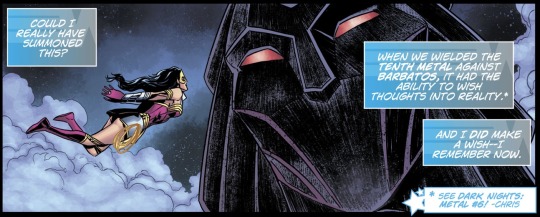
Diana [narration]: Could I really have summoned this? When we wielded the Tenth Metal against Barbatos, it had the ability to wish thoughts into reality.*
Ed. note: * See Dark Nights: Metal #6! — Chris
And a couple of pages later —

Karnell [narration]: ...our beautiful world — which you regard as the ‘Dark Multiverse’ — we see as a paradise… where we were more than even gods to our worshippers… we were everything!
I didn’t read Metal and I’m not planning to. That’s not a value judgement, it’s just not something that sparks my interest.
But it means I don’t know who the bloody hell Barbatos is, and I’ve never heard of the Tenth Metal. I don’t know what the Dark Multiverse is, or how it works, or how it differs from the regular multiverse. When Robinson says Diana made an inadvertent wish while she was wielding this Tenth Metal, I don’t know if he’s picking up on a story point in Metal that I need to read up on.
So right off the bat, Robinson has alienated anybody who isn’t familiar with the event comic he’s drawing from.
And what infuriates me is that at the same time as he was doing all this, Robinson was getting muddled by Wonder Woman’s continuity, conflating superseded New 52 canon with (contradictory) Rebirth canon, inadvertently retconning things and failing even to keep his own narrative consistent. I’d argue he needed to spend less time making references to other comics and more time making sure he understood the one he was writing.
Robinson: [...] what I've always loved about Wonder Woman is her strength. Even when she was in that phase in the white costume, where she didn't have her powers, she had great strength.
Oh, you mean this era?

The era where Diana lost not only her powers, but all of her training and skills? Where she became a weepy, insecure romantic heroine, reliant on men to guide and save her from her own inexperience and her uncontrollable female emotionality? The era where she was constantly crying over her latest rugged love interests? That awesome era?
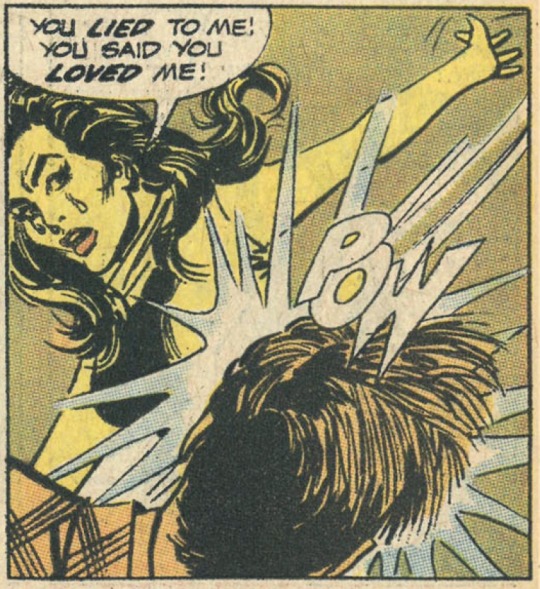
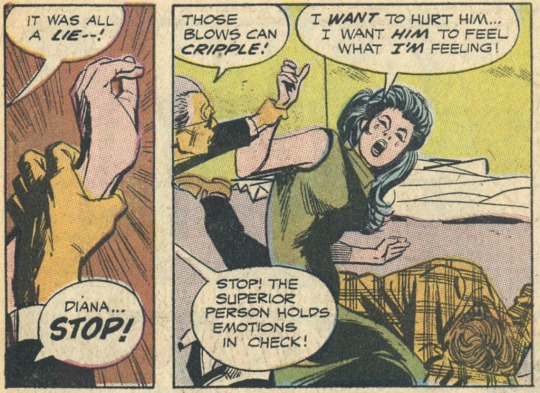
(Also misogynistic, racist and homophobic as fuuuuuck, but that’s another discussion.)
One of the reasons that era ended was because Gloria Steinham [sic] said, "Hey, she's Wonder Woman! She's a superhero and you've taken away her powers!"
But I actually thought her lacking powers was like saying, I don't need them to be a strong woman. And I think that was almost a more powerful message. I was surprised Ms. Steinem didn't get that, to be quite honest with you.

This is a characterisation of Steinem’s role in that period of Wondy’s history that I’ve seen before (always from men in the comics field), and it’s never sit well with me. It carries an unpleasant shade of gatekeeping.
The implication is that Steinem’s feelings about Wonder Woman (a character had loved since childhood) were less valid or even flat-out incorrect because she hadn’t read the right comics, that she was an ignorant outsider who ruined a good thing by coming in with a political agenda and trying to make Wonder Woman about feminism, that she didn’t have a right to complain about the comic because she wasn’t a ‘real’ fan.
And what Robinson doesn’t mention, as critics of Steinem and Ms. Magazine’s lobbying for a return to the classic Wondy rarely do, is that this campaign was set against a backdrop of unimpressive sales numbers and a struggle over the new direction that eventually gave rise to an ambitious and quite likely divisive ‘women’s lib’ arc written by African-American sci-fi writer Samuel R. Delany, which was intended to culminate in Diana triumphing over a group of male thugs attempting to shut down an abortion clinic run by women surgeons.
I have no doubt that Steinem played an important role in the way events panned out, but I’m also not surprised the ‘women’s lib’ arc never made it past its first issue.
(It was a truly dreadful first issue, btw, though the whole story behind it and what Delany was trying to do with it is fascinating.)
But that didn’t stop DC from kicking off Wondy’s superpowered return with the murder of a composite character representing Steinem and female DC editor Dorothy Woolfolk (whose name had previously been floated as editor for the book).
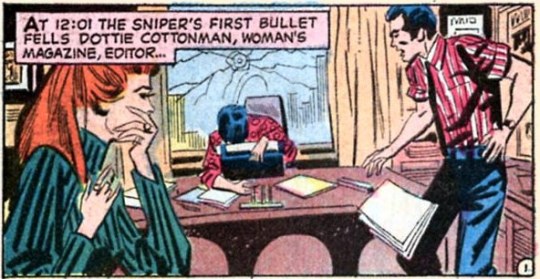
Then as now, Steinem got blamed by the gatekeepers for daring to interfere with Wonder Woman.
Nrama: Do you think Jason picked up some of her strength over the course of his story arc during your run?
Robinson: I think so, at least at the beginning as he was starting to develop. Now, technically, I suppose he's more powerful than her in that he has the power of their father Zeus and the power of storms and air control and things like that.
I like the fact that when he's given this armor, he realizes that his sister should have gotten it.
And he knows that the powers he has do not make him the better hero.
He knows his sister is the better hero.
So by the end of it, he just wants to be worthy of her, which I think was a nice character arc for him.
I can see how Robinson tried to achieve this character arc, but I wouldn’t call it anything close to a success.
Jason started as a deeply, deeply unlikeable character. He’s deeply selfish and emotionally immature. He doesn’t think about the consequences of his actions, mostly because he’s only ever concerned about how things affect him. When he learns about the mother he never met, when his adoptive father vanishes, every time Hercules leaves on one of his journeys, as he follows his twin sister’s heroics through the media — his thoughts are never about them and what they’re doing, or how they’re feeling, or if they’re okay. It’s always about how they’ve failed him, wronged him, abandoned him.
When we first meet him, he is helping goddamn Darkseid to systematically murder his own siblings. And it’s not because he’s being mind-controlled, or elaborately manipulated into believing that Darkseid is the good guy. It’s because he hates the guts out of Diana, the sister he’s never met, because he believes he’s entitled to the life that she has, and he wants to kill her for it.
If you want to get your readers past all that, you need one hell of a redemptive arc, and that’s one thing Jason never gets.
Because what happens next, after Jason gets an attack of conscience and switches sides, is that he freeloads off Diana, trashes her house, guilt trips her when she tries to set boundaries, and then when, heroism and glory don’t immediately come easily to him, runs away from home in the middle of the night.
The next time we see him is when he returns with the armour and a personality change. He’s still inexperienced, brash, impulsive and annoying, but that’s more or less the extent of it — he’s no longer the thoroughly objectionable character we saw in his first seven issues, and there’s no real explanation for the change.
Really, the vast majority of Jason’s character development takes place in the space between his disappearing at the end of WW #40 and reappearing at the end of WW #41.
Nrama: Wonder Woman #50 definitely feels like it's an ending to your time on Jason's character, and even his time in the book.
Robinson: It definitely has an element of finality to it, but Jason can be there for other writers, or indeed me, if I ever got to write him again.
Excuse me? If you ever got to what now?
Nrama: Is that a hint?

Robinson: I do enjoy writing him. I have this vague fantasy of one day doing a story and calling the comic Jason's Quest, which is an old DC title.

But no one's asked me so far and probably won't. So it's just something in my mind right now.
please, dear god in heaven, please let it stay there.
27 notes
·
View notes
Text
Thoughts on Dio
The reason for Dio’s superiority complex is his inferiority complex.
He constantly has to assure himself he’s better than everyone else
Part 1 human kid Dio’s insecurities are most obvious, he loses his temper when Erina upstages him after he tried to embarrass her, all his attempts to prove how much better he is than Jonathan lead to Dio getting beaten to a pulp by him (with Dio in total disbelief). Dio’s reaction? He breaks down and cries, while saying he can’t believe a filthy mutt like Jonathan dared to do this to him. This is the moment Dio’s obsession with Jonathan starts.
He won’t deem anyone near his level, he never learns to love his new father, thinking he’s a fool who doesn’t deserve such a fortune until the bitter end. He also interprets George’s attempts to make Dio feel welcome as nothing but mere charity work from him.

But Dio’s plans fail again. He’s exposed by Jonathan and Speedwagon calls him evil to his core (he says the three moles on Dio’s ear are a mark from the Devil). Never wanting to experience such a fall again, but still desperately determined to prove he’s superior to others, he accepts Speedwagon’s comments and rejects his humanity.
As a man who’s embraced evil and who rejected his humanity, Dio’s especially petty about his supposed superiority in his early vampire days: he attaches human heads to those of animals and makes a mother eat her baby to show how everyone around him is no better than a beast to him.
At the end of Part 1 he decides only Jonathan is worthy of his respect, this is a vital part of his later reflections after Part 1 which are a major reason for the way he’s changed in those later parts.
It should also be taken into account that Dio saying how he sees Jonathan as his equal and then being confronted with his death must’ve been shocking to him: Dio sees himself as unkillable yet his other half just died. With this fact, Dio’s left alone with his thoughts for over 100 years on the bottom of the ocean..
Dio from part 3 is much more interesting of a philosopher. When fighting Jonathan’s descendants he may still be going on about being superior, the ruler of the world etc. (maybe it’s for the memoriez, for old time’s sake), but before the final fight Dio’s often seen on his own instead of surrounded by mindless zombies, reading a book, or philosophising with Enyaba. Dio finally isn’t just basking in his superiority, he now allows people to follow him and has thoughtful discussions with Enyaba and Pucci. This is the best proof of why P6 Dio is not that much of a retcon. Even more, Dio talking to Polnareff about how living is about overcoming anxieties and fears and living with a sense of security, fits perfectly into his P6 philosophy of what it means to achieve heaven, an ambition that is finally realized by Pucci. (To me achieving heaven means liberating humanity from their existential dread, which I believe to be the core fear and question (therefore anxiety) of self-aware humans. I believe religion itself is an attempt of humans to free themselves from their existential crises. However, Pucci’s vision (which can be equated with that of Christianity) is wrong. By achieving heaven Pucci thinks he’s elevating people to their ultimate state, and he thinks that this will make them happy, but a world without wonder and uncertainty can also not have hopes and dreams. Humanity’s ambitions to better understand themselves and the universe would come to a standstill. If your entire life has been laid out for you, you have no reason to find purpose in your life, which means there isn’t any purpose, since purpose and meaning is something you create yourself (Sartre: in our life there is no true meaning, but you should still create your own to live a fulfilling life). Pucci’s idea of making people happy really does seem like he’s trying to bring paradise back to humanity. In Paradise Adam and Eve lived for fun, without any sense of wonder since everything they should know had already been told to them: “You were made to enjoy Paradise and each other’s company, forever”. As long as they didn’t eat from the tree of knowledge, they lived without wondering about anything. There are many intellectuals who have sympathized with Adam’s, Eve’s and Satan’s sinful behaviour. It looks like Araki does too. Something I always wondered is how long Adam and Eve would have enjoyed their time in Paradise? Would they really never have gotten tired of it even after centuries? I think they would eventually eat the apple in the hope of dooming themselves after having become bored of it all. Humans in Pucci’s heaven might become suicidal as well, when they realize there’s nothing new for them to experience. To me this is why Pucci is a perfect conclusion for Dio’s story and philosophy, who after becoming immortal still wouldn’t be satisfied: of course the man who got obsessed with becoming God wouldn’t have been content after achieving heaven either, it might even be the moment he’d become fatally depressed.
Eternal life is suffering.

But coming back to his superiority/inferiority complex: Dio may even have fooled himself even more into thinking he’s superior to everyone now that he possesses the body of such an extraordinary man, instead of the one he got from his disgusting father. Dio’s often admiring his body, and touching it (Dio was 100% gay for Jonathan) Dio continues to believe no one (except Jonathan) could ever reach him. But the height of his grandeur is this: he may have thought himself to be a literal god from the moment he rejected his humanity and embraced being called evil, but now he gladly claims the role of God (I personally connect DIO being written in caps in P3 with him becoming more like the Christian God, yes it’s a total leap, but I like the idea): he may be unreachable but he is an inspiration, he doesn’t surround himself anymore with mere ghoulish creatures, but devout followers whom he deems useful. Like God, he now has a group of followers, you could call them believers. (throwback to Dio playing God towards Polnareff at the stairs).
Polnareff represented humanity in both this scene and Diavolo’s stairs scene. He couldn’t get closer to Dio as a metaphor for humans desperately trying to be with God but never being able to reach him. His panic when Diavolo is approaching him also works as a symbol for humanity’s futile attempt to get away from Hell at the terror of it seeming to be getting closer to them (for the non believers: substituting the fear of Hell with the fear of oblivion also works).
Dio losing to Jotaro was actually more of a game of wit than you think: Jotaro noticed Dio’s insecurity hidden behind his boasting of being superior and exploited it: Jotaro might have noticed it at first when Dio attempts to hide the scratch Star Platinum gives to his face when they’re comparing each others punch rushes for the first time . Jotaro later exploits this by making Dio think he can manipulate time with his magnet trick: this causes a crack in Dio’s overconfidence and immediately reveals the insecurities he was supposedly hiding so well. Dio reassuring himself that this was just a trick and he has nothing to worry about, might have been Jotaro’s intention so he could stall time to figure out how to move in frozen time or even use time stop. At the same time, convincing Dio he’s superior afterwards was crucial to defeat him. This is because Dio doesn’t view a fight as a battle, but a fun game in which he can prove how much he’s above everyone else (resisting is muda). This is his fatal flaw, because the Joestars are tenacious enough to keep fighting even in the most dire situations (even though he says he promised himself not to show any mercy towards the Joestars anymore, Dio can’t resist holding off killing Jotaro until he’s fully confident he’s superior). Dio could have ended the fight many times, but kept getting tricked by Jotaro until it was too late (for example, Dio thought Jotaro tried to make Dio believe he could not move in frozen time so he could get within Dio’s range while in fact, the first time he used the magnet trick, Jotaro actually wasn’t able to attack Dio when he got closer in frozen time. Instead, Jotaro did it primarily to protect himself and as a psychological attack (because right before the magnet trick, Dio said he had seen enough and would finish Jotaro off with The World→Jotaro knew he needed to shatter Dio’s confidence at that moment or he would have been killed). The entire fight must have been extremely memorable to Dio, who seemed to have matured, who seemed to have become such an interesting thinker reflecting on the desires of mankind (and heaven when including P6 Dio). It actually kind of makes sense how so much of a spectacular battle causes him to tap back into his more explicitly grandiose self from P1.
*Star Platinum and The World being Jonathan’s spirit is a fantastic theory: we know how Dio develops a stand by piercing his body with an arrow but this is Jonathan’s body as well. He has the same Hermit Purple as the oldest Joestar with a stand, and The World is pretty much exactly the same kind of stand as Star Platinum. There’s also a fanmade drawing of how Dio could’ve realized he had been fighting the spirit of Jonathan Joestar when seeing Jonathan in Star Platinum. Though I prefer Dio dying in total incomprehension at being defeated by someone he thought to be inferior, it’s still a nice alternative that would totally have worked.

Dio’s fear of the sea, or being submerged under water: Stand is a scuba diver, as if the manifestation of his soul represents his subconscious: someone who had to endure being submerged under water. Dio also stays in Egypt, a place known for having deserts and thus very few bodies of water. In his conversation with Pucci he’s building a toy ship but the ship is actually sinking, there’s even people in the water who might be drowning. His reaction at Jotaro describing how Dio feels as “holding your breath underwater as long as possible and suddenly being dragged down when trying to come up again” might also be an indication of this.
Jonathan or Dio, which path do you follow?
Both had to endure a rough unfair world but reacted in different ways.
1 note
·
View note